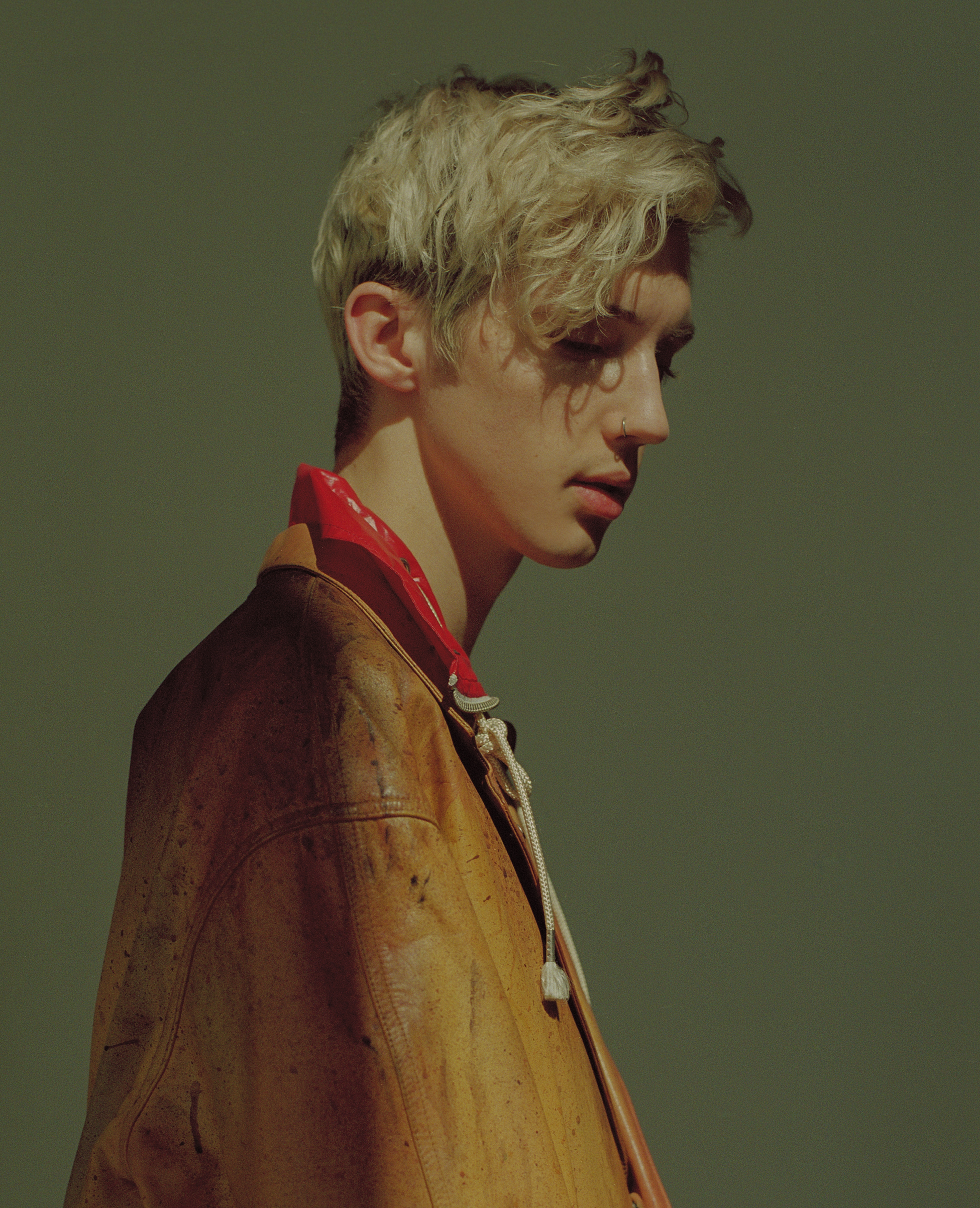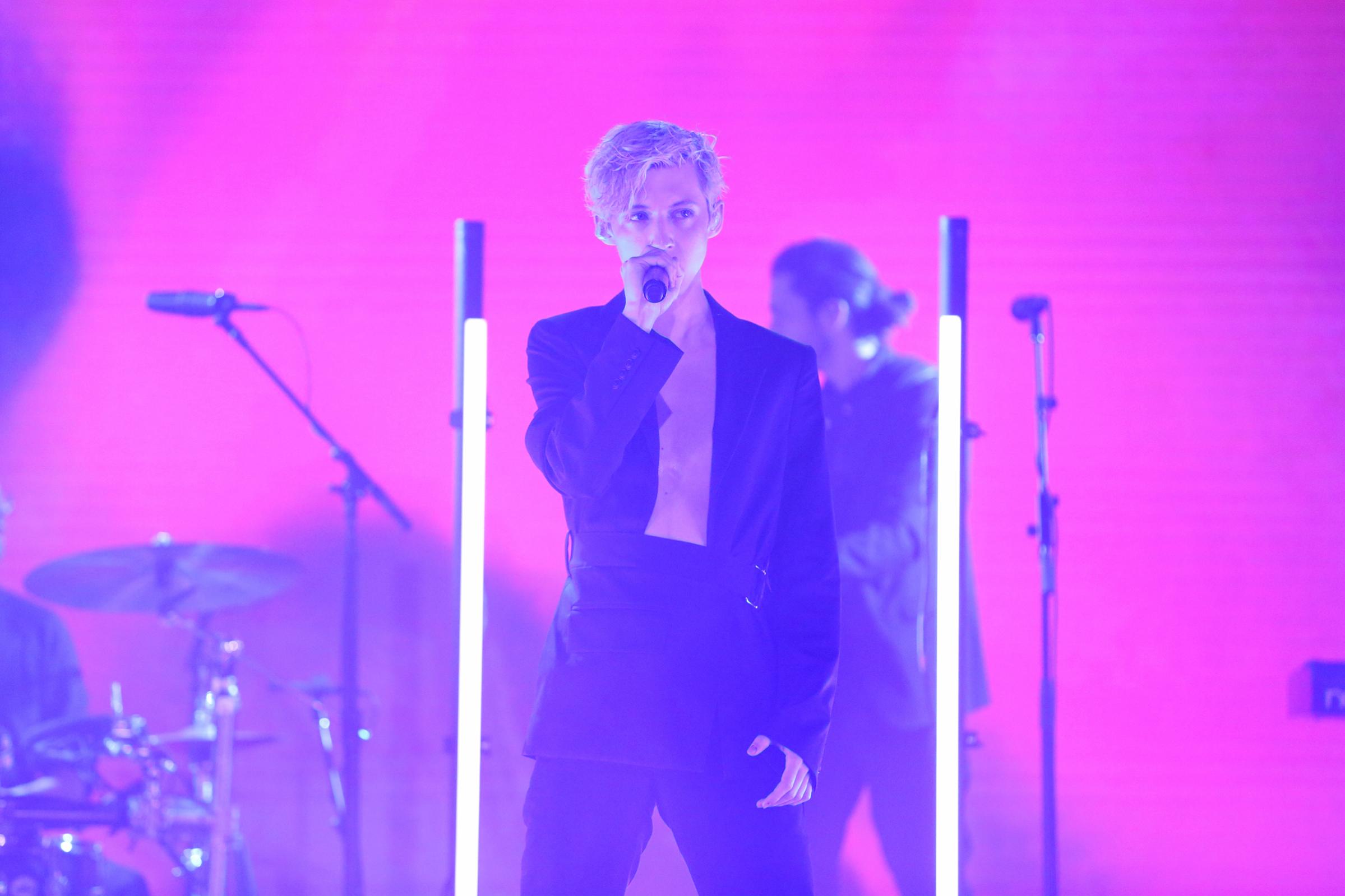Troye Sivan, global pop star, shows up to his photo shoot alone. No manager. No assistant. No glam squad. Just a slight 23-year-old with wide blue eyes, artfully floppy bleached-blond hair and a voice that has captured the hearts of a millions-strong fandom, spread out everywhere from his hometown in Australia to his adopted home in Los Angeles. When Sivan stretches out his hand to introduce himself, he says his name earnestly: He’s Troye. He’d like you to know about him. He’d like you to like him, and his music; his new album Bloom is out Aug. 31. But more than anything, he’d like to be there for you.
“I just want to provide for a young audience what I felt was lacking when I was a kid,” he says, “which was representation of someone living their life.” When Sivan talks about representation, he’s talking about representation for someone like him: queer, sensitive, thoughtful.
Sivan is different from many of the stars who have come before. But for him, that’s an asset, not an impediment. His music–delicate dance-pop that has notched hundreds of millions of streams, a Saturday Night Live appearance and one big Top 40 hit (“Youth”)–has already won him fans like Bloom collaborator Ariana Grande and Taylor Swift, who brought him onstage during a recent stadium tour date. Maybe it’s because Sivan is more than just your average pop star. He built a platform as a digital influencer first, building connections with fans who related to his unapologetically queer identity, then used his Internet following to buoy him to stardom as a bona fide artist. And it’s working: Bloom marks a major artistic achievement, evoking influences from the Velvet Underground to Simon & Garfunkel, all wrapped up in a sleek pop package.
Born in Johannesburg, Sivan and his family moved to Australia when he was 2, where he was raised in a sleepy suburb of Perth; he calls his childhood in a mostly Jewish community there “idyllic.” His first music memories include watching Michael Jackson videos on VHS and knowing, even then, that singing and dancing were in his future. By age 7, he was taking voice lessons. But it was YouTube that made all the difference. He was about 12 when he started uploading videos of himself singing and sharing recorded musings. In old clips, you can already clock Sivan’s preternatural connection with the camera, and his comfort in its detached gaze; he is a true digital native.
By the time he was 16, Sivan was one of Australian YouTube’s most-followed accounts. He secured a manager, a role in a Hollywood film (X-Men Origins: Wolverine) and a devoted audience for his videos.
In a 2013 video post, Sivan came out publicly to his legion of fans, potentially jeopardizing his lifelong dream of pop stardom; he was negotiating a record contract at the time. But the risk paid off. Sivan has become a gay icon for a digital-savvy generation, with that video alone racking up more than 8 million views. Capitol Records, meanwhile, signed him–a perfect gift for the day before his 18th birthday. “I have no idea how I would have ever gotten started had it not been for the Internet,” he says. To Sivan, YouTube and social-media platforms aren’t just tools used for publicity. They’re the medium, and his life is the message.
Sivan credits the friends he found online with helping him become comfortable with his identity early on. “I owed it to the community to tell my story and help some other people in the process,” he says. When he first shared music videos for his 2015 debut album, Blue Neighbourhood, critics buzzed about his casual embrace of same-sex romance. It wasn’t a gimmick, though; it was just Sivan as Sivan, which the fans were happy to support.
That story continues in his latest additions to his YouTube canon: bold, sensual music videos to go along with the singles on Bloom that are rich with artful, gender-blurring visuals. In the videos, Sivan sports red lacquered lips, reclines in high fashion and dances in high heels. To him, filming those moments was a peak: “This is what you wanted your entire life,” he says he told himself. “I had a bit of envy in how confident he was in his queerness,” says Sivan’s Bloom co-writer Brett McLaughlin, who performs under the name Leland. “I was like, This is what I want to be a part of. This is the train I want to be on.” The response to the visuals, Sivan says, “felt electric.”

Sivan isn’t the first male pop star to identify as openly queer or defy gender norms; award-winning artists like David Bowie, Elton John and Sam Smith already broke through those barriers. Nor is he the first to pivot from his fame on a digital platform to a more traditional celebrity career. Consider Justin Bieber or Shawn Mendes, both of whom got their start uploading videos as well. But his seamless transition from YouTube vlogger to actor to major-league pop star, using his fan base to test the boundaries of what’s expected from male artists, is a case study in the form. Instead of being introduced to Sivan through his music, fans became familiar with him over a decade of online interaction. They’ve tracked him from project to project, growing with him. Their support transcends the strength of any one song, and they’ve given him implicit permission to express himself authentically. It’s a uniquely modern experience of stardom, and it sets Sivan apart.
“It’s all a part of the story,” says McLaughlin. “I don’t think it makes Troye any less powerful in terms of his music. It just adds accessibility.” Luckily, Sivan’s viral start led to a well-received debut album with a platinum hit, granting him credibility in the music industry.
On Bloom, Sivan continues his musical evolution, pairing effervescent dance anthems like lead single “My My My!” with more dreamy, introspective fare; he calls this album a “time capsule” of the past few years. “The Good Side,” a melancholy acoustic number, was made by indie producer Ariel Rechtshaid (Haim, Kelela) and earned Sivan comparisons to indie-folk stalwart Sufjan Stevens. On dancier numbers, like the slow-burning “Plum,” breathy Grande duet “Dance to This” and flirty title track, he sets off little sparks of joy among the cool-toned soundscapes. And on the lush album highlight “Seventeen,” Sivan reflects on a formative but complicated romantic experience: “Maybe a little too young, but it was real to me,” he sings.

Radical transparency like this is unusual in the highest echelons of pop stardom, but it’s important to Sivan to be honest about his own experiences. On Bloom, he flips from documenting explicitly queer narratives to using gender-neutral pronouns. He says he grew up feeling accepted in his queer identity, and it was important to him to make music that felt equally non-judgmental. “I wanted to be a pop star since I was a little kid,” he says. “What do pop stars do? They write love songs. They put love interests in their videos. I don’t see it as some radical statement.”
He wants fans to feel connected with the causes that matter to him too. Sivan teamed up with LGBTQ organizations including the Ally Coalition and the Trevor Project to promote local activism while he’s on his upcoming tour. He also appears alongside Lucas Hedges and Nicole Kidman in the upcoming film Boy Erased, out this November, about a young man who lands in conversion therapy. He’s cautious when he talks about his need to be a role model in the LGBTQ community: “This is a responsibility that I take really seriously.”
If staying poised and apolitical used to be the savviest move for stars who wanted to play to the largest possible audience, Sivan represents a new kind of celebrity, who’s comfortable engaging with social issues and getting vulnerable with fans. He and his contemporaries are eager to be seen and valued as role models and friends to a generation growing up in uncertain times while seeking new modes of connection with one another and the world. And Sivan knows that his popularity creates more space for people who look and act like him. “There’s a lot of hunky straight white male pop stars,” Sivan says, “but I think we’re heading in the right direction.”
Back at the photo shoot, Sivan strikes pose after pose, awash in warm morning light. He may stand alone in the camera’s flash, but whatever he does, he knows his fans will follow.
This appears in the September 03, 2018 issue of TIME.
More Must-Reads from TIME
- Donald Trump Is TIME's 2024 Person of the Year
- Why We Chose Trump as Person of the Year
- Is Intermittent Fasting Good or Bad for You?
- The 100 Must-Read Books of 2024
- The 20 Best Christmas TV Episodes
- Column: If Optimism Feels Ridiculous Now, Try Hope
- The Future of Climate Action Is Trade Policy
- Merle Bombardieri Is Helping People Make the Baby Decision
Write to Raisa Bruner at raisa.bruner@time.com